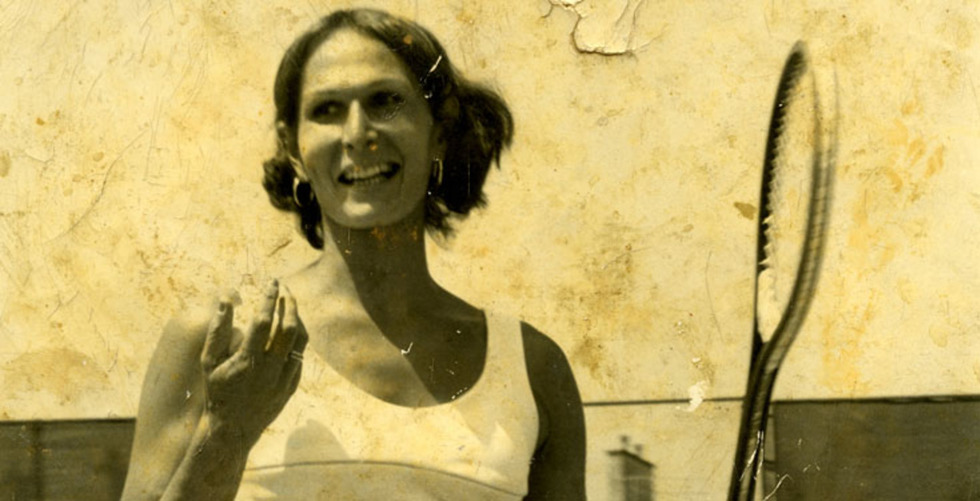
BY KRISTIN MC CRACKEN |
Renée: Be Who You Are
As the first openly transsexual tennis player, Renée Richards' story made headlines and history on and off the courts. See Eric Drath's still-timely doc On Demand via Tribeca Film.

Note: This interview first ran as part of the 2011 Tribeca Film Festival coverage. Renée is currently available On Demand via Tribeca Film. Enter your ZIP code to find out how to watch it where you are.

Tribeca: Tell us a little about Renée:
Eric Drath: Renée Richards is probably one of the most interesting sports figures of the 20th century. Not only was she a pioneer on the courts, but she went through [even more] in her [personal] life. She was an incredibly accomplished male—Richard Raskind—who went to Yale, was captain of the Yale tennis team, and was even scouted by the Yankees as a baseball player. He went to medical school, became a world-renowned doctor, and then decided to have a sex change. He went to Casablanca, changed his mind, came back, married a model, then had a son, and then 3 years later decided to go through with the sex change.
Renée was born, and she started playing tennis out in California, and the story became worldwide news. Renée could have just said, “Okay that’s it, I’m just going to go back to practicing medicine,” but instead she decided to become a pioneer and carry the torch for many people out there whom, for whatever internal struggle they were having, she gave them hope. She was a catalyst, to show that people can not only change, but they can stand up for what they believe. You can just imagine back then what it was like—
Tribeca: That’s what struck me: that it was so long ago [the 1970s], and that if this happened now, the same kind of taboos and things would come up. We see some of those cases out there now, like the runner from—
Eric Drath: From South Africa.
Tribeca: South Africa, yeah.
Eric Drath: It’s the internal fortitude she had to keep going. This movie is not really a sports movie, although certainly, it has that sports angle which always magnifies any story.
This is a story a lot about identity—about how we see ourselves and how the rest of the world sees us. We all tell ourselves this narrative about ourselves, and the world sees a different narrative about us. It’s more important for Renée to be identified as a woman than to have a sexual life; being a woman is more important than anything.
Tribeca: So how did it come about that you decided to make a movie about her?
Eric Drath: I was born and raised in New York City, and my sister, when she was young, went to a doctor, Dr. Richard Raskind. She had an eye muscle issue, and he was becoming one of the best practitioners for certain types of eye problems. And then a couple of years later—we were somewhat of a tennis family—all of a sudden I hear, “Oh, Renée Richards is on the tennis court… Oh, did you hear about that?” You know, little whispers and whatnot…

Tribeca: And how old were you?
Eric Drath: I was 7 when she played at the US Open. But I still remember things from back then: the US Open was on in the living room, and the family sat around to watch it. (We also went to the US Open a lot.) I just knew that this was one of the fascinating stories. I was like: How can that happen? How can they let a man play tennis as a woman? And that was my first stage of understanding the story.
Then I started digging deeper and deeper and deeper. In making the film, I found so many other things about gender dysphoria, which is classified now as a medical condition.
Tribeca: So how did you connect with her? Did you have any other connection to her?
Eric Drath: No, I just picked up the phone. I called her office, and at first she was very reluctant to have the spotlight shone on her again. She hasn’t been one of those people that’s been out front of the LGBT world at all; in fact, she doesn’t really indentify that much with LGBT, interestingly. She says transgender people, or transsexuals as she refers to herself, they don’t want the T. She is a woman, she don’t want to be lumped into the gay, lesbian this, that. So I found that interesting, and then I found one complexity after the next when I started talking to her—you’ve got to remember: this is a super, super smart individual. I spent hours and days and weeks talking to her and asking her questions: Why did you do it? How’d you do it? What was it like? I think the film is an intimate portrait of her, her character, and her story.
Tribeca: Why did she say yes eventually? Did she warm up to you, did it take a while?
Eric Drath: Yeah, it did take awhile. I was persistent—I’m a former journalist, so I can dog someone if I have to. I just stayed said, “Listen, a new generation needs to hear your story. This is a story that transcends tennis, transcends transsexualism, transgenderism. This is a story about courage, about being who you are.” No matter how other people see her, she had the courage to step out in the world. And that’s something that I think is universal. She was reluctant, but I kept imploring her to speak to me, and finally she did.
Tribeca: What did you learn on this film that was different from your first film? Do you have any advice for inspiring filmmakers who see you coming to Tribeca?
Eric Drath: I haven’t thought about that… We started this film independent, completely independent. My partner Barry and I, we just said, let’s put our money up, let’s do this film, with no assurance of distribution. That’s independent filmmaking like no other way.
So I learned, in both films, making these documentaries is tough because there are points where you’re like, “Oh my God, I’ve got nothing, I just spent all this money! What am I going to do? This isn’t going where I want it to go.”
But then I would say never ever quit! No matter what! Making a film, you have to be committed. So I would say it takes passion, you’ve got to be persistent, and if you want to do this story, you have to keep going and keep going and going and you have to be determined to finish it.

Tribeca: What are your hopes for Renée and Tribeca Film? What do you want audiences to take away from her story?
Eric Drath: One: I would love people to be like, “That was a fantastic movie, something that really made me emote and really was a great entertaining piece.” And the other thing is I would like a discussion afterwards. I’d like people to really talk about these issues because these issues are important, I mean this is just touching the iceberg of issues about sexuality, gay marriage…
Tribeca: And they are all still relevant 30 to 40 years later!
Eric Drath: Totally relevant! You know, even today: “You can have civil rights, and you can transgender and you become a female.” “But what about sports?” “Okay, you can become a transgender or transsexual, but you can’t play sports…” I mean, you can debate that all day: Was it fair or not? Is it fair? Those are the types of questions that I would like for people to take away.
Tribeca: Will Renée be at the Festival?
Eric Drath: Yes! And I think Billie Jean King might come, Martina Navratilova, some other people—we’re working on it now.
Tribeca: If you could have dinner with any filmmaker alive or dead, who would it be?
Eric Drath: Darren Aronofsky. I loved Black Swan, and I like The Wrestler, and I would like to have dinner with him.
Tribeca: What piece of art (book/film/music/TV show) are you currently recommending to your friends most often right now?
Eric Drath: I would recommend The Fab Five on ESPN. That was excellent.
Tribeca: What would your biopic be called?
Eric Drath: A Life Driven by Passion.
Tribeca: What makes Renée a Tribeca Film must see?
Eric Drath: There’s no other film like it, guaranteed—it touches upon such important social questions.
Produced by ESPN Films, Renée will premiere on ESPN October 4.
Renée is currently available On Demand via Tribeca Film. Click to find out how to watch it where you are.
The Tribeca/ESPN Sports Film Festival On Demand is available in more than 40 million homes via cable, telco and satellite systems. Additionally, some titles are available on the web via digital On Demand services. Browse the titles for specific platforms.